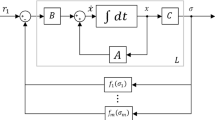Abstract
Within the lattice approach to analysis and synthesis problems recently developed in Quadrat (Signal Syst, to appear), we obtain a general parametrization of all stabilizing controllers for internally stabilizable multi input multi output (MIMO) plants which do not necessarily admit doubly coprime factorizations. This parametrization is a linear fractional transformation of free parameters and the set of arbitrary parameters is characterized. This parametrization generalizes for MIMO plants the parametrization obtained in Quadrat (Syst Control Lett 50:135–148, 2003) for single input single output plants. It is named general Q-parametrization of all stabilizing controllers as we show that some ideas developed in this paper can be traced back to the pioneering work of Zames and Francis (IEEE Trans Automat control 28:585-601, 1983) on H ∞-control. Finally, if the plant admits a doubly coprime factorization, we then prove that the general Q-parametrization becomes the well-known Youla-Kučera parametrization of all stabilizing controllers (Desoer et al. IEEE Trans Automat control 25:399–412, 1980; Vidyasagar, Control system synthesis: a factorization approach MIT Press, Cambridge 1985).
Similar content being viewed by others
References
Anantharam V (1985) On stabilization and existence of coprime factorizations. IEEE Trans Automat Control 30:1030–1031
Bonnet C, Partington JR (2005) Stabilization of a class of delay systems using PI methods. INRIA report RR-5583
Bourbaki N (1989) Commutative algebra, Chapts 1–7, Springer, Berlin Heidelberg New york
Coquand T, Lombardi H, Quitté C (2004) Generating non-Noetherian modules constructively. Manuscripta Mathematica 115:513–520
Curtain RF, Zwart HJ (1991) An introduction to infinite-dimensional linear systems theory, TAM 21, Springer, Berlin Heidelberg New york
Desoer CA, Liu RW, Murray J, Saeks R (1980) Feedback system design: the fractional representation approach to analysis and synthesis. IEEE Trans Automat Control 25:399–412
Eisenbud D, Evans EG, Jr (1973) Generating modules efficiently: theorems from algebraic K-theory J. Algebra 27:278–305
Fuhrmann PA (1976) Algebraic system theory: an analyst's point of view. J Franklin Inst 301:521–540
Georgiou TT, Smith MC (1990) Optimal robustness in the gap metric. IEEE Trans Automat Control 35:673–685
Heitmann RC (1984) Generating non-Noetherian modules efficiently. Michigan Math 31:167–180
Khargonekar PP, Sontag ED (1982) On the relation between stable matrix fraction factorizations and regulable realizations of linear systems over rings. IEEE Trans Automat Control 27:627–638
Knebusch M, Zhang D (2002) Manis valuations and Prüfer extensions I. a new chapter in commutative algebra. Lecture notes in mathematics 1791, Springer, Berlin Heidelberg New York
Kučera V (1979) Discrete linear control: the polynomial equation approach, Wiley, New York
Lam TY (1978) Serre's conjecture, Lecture notes in mathematics 635, Springer, Berlin Heidelberg New York
Lin Z (2001) Output feedback stabilizability and stabilization of linear n-D systems. In: Galkowski k, Wood J, Francis (eds) Multidimensional signals, circuits and systems,
Logemann H (1993) Stabilization and regulation of infinite-dimensional systems using coprime factorizations. In: Analysis and optimization of systems: state and frequency domain approaches for infinite-dimensional systems, Lecture notes in control and information 185, Springer, Berlin Heidelberg New York
Mori K (2002) Parametrization of the stabilizing controllers over a commutative ring with applications to multidimensional systems. IEEE Trans Circ Sys 49:743–752
Quadrat A (2003) The fractional representation approach to synthesis problems: an algebraic analysis viewpoint. part I: (weakly) doubly coprime factorizations. part II: internal stabilization. SIAM J Control Optim 42:266–299, 300–320
Quadrat A (2003) On a generalization of the Youla–Kučera parametrization. part I: The fractional ideal approach to SISO systems. Syst Control Lett 50:135–148
Quadrat A (2004) On a general structure of the stabilizing controllers based on stable range. SIAM J Control Optim 42:2264–2285
Quadrat A (2005) A lattice approach to analysis and synthesis problems. Math control Signals Syst (to appear)
Quadrat A (2005) An algebraic interpretation to the operator-theoretic approach to stabilizability. part I: SISO systems. Acta Applicandæ Mathematicæ 88:1–45
Quadrat A (2003) A generalization of the Youla–Kučera parametrization for MIMO stabilizable systems. In: Proceedings of the workshop on time-delay systems (TDS03), 08-10/09/03, IFAC Workshop, INRIA Rocquencourt, France
Quadrat A (2004) Every internally stabilizable multidimensional system admits a doubly coprime factorization. In: Proceedings of mathematical theory of networks and systems (MTNS04), 05-09/07/04, Leuven, Belgium
Quadrat A (2004) ``Stabilizing'' the stabilizing controllers. In: Proceedings of mathematical theory of networks and systems (MTNS04), 05-09/07/04, Leuven, Belgium
Rotman JJ (1979) An introduction to homological algebra. Academic Press, New York
Shankar S, Sule VR (1992) Algebraic geometric aspects of feedback stabilization. SIAM J Control Optim 30:11–30
Sontag ED (1977) The lattice of minimal realizations of response maps over rings. Math Systems Theory 11:169–175
Srinivasan VK, Hu Shaing (1979) A theorem in Banach algebras and its applications. Bull Austral Math Soc 20:247–252
Sule VR (1994) Feedback stabilization over commutative rings: the matrix case. SIAM J Control Optim 32:1675–1695
Sule VR (1998) Corrigendum. SIAM J Control Optim 36:2194–2195
Read CJ (2001) All primes have closed range. Bull Lond Math Soc 33:341–346
Vidyasagar M (1985) Control system synthesis: a Factorization Approach, MIT Press, Cambridge
Youla DC, Bongiorno JJ, Jabr HA (1976) Modern Wiener-Hopf design of optimal controllers, part II: The multivariable case. IEEE Trans Automat Control 21:319–338
Zames G, Francis BA (1983) Feedback, minimax sensitivity, and optimal robustness. IEEE Trans Automat Control 28:585–601
Author information
Authors and Affiliations
Corresponding author
Rights and permissions
About this article
Cite this article
Quadrat, A. On a generalization of the Youla–Kučera parametrization. Part II: the lattice approach to MIMO systems. Math. Control Signals Syst. 18, 199–235 (2006). https://doi.org/10.1007/s00498-005-0160-9
Received:
Revised:
Published:
Issue Date:
DOI: https://doi.org/10.1007/s00498-005-0160-9




